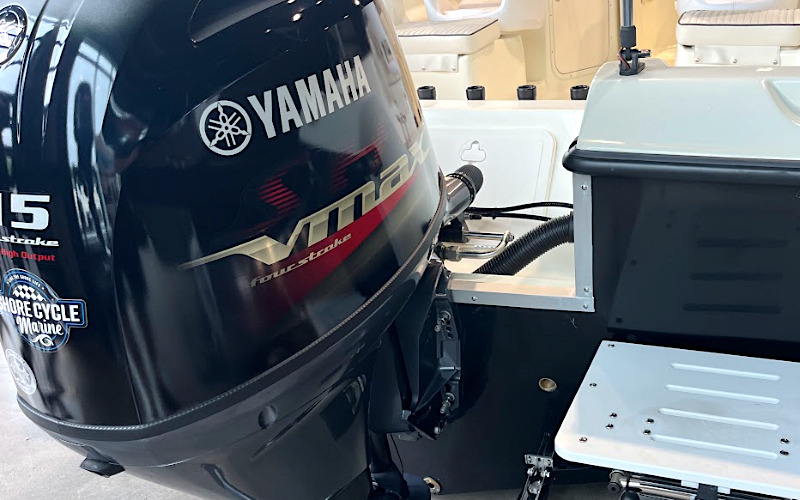
Which Outboard?
Choosing the right outboard motor for your boat, particularly in the mid to high power range of 90 to 225 horsepower, involves considering several factors. This guide will provide an in-depth look at Yamaha, Suzuki, and Mercury brands, with a focus on engine configurations, alternator outputs, and practical implications for boaters.
Horsepower Needs
Are you fishing, cruising, or engaging in watersports? Each activity has different power needs. A common rule of thumb is 1 horsepower for every 25-30 pounds of the boat’s weight.

Using the popular Coastal-Vokey 198 Walk Through as an example, the "dry weight" of the boat is 1,800 lbs and you add a 500 lb motor, other accessories like a canopies totalling 300 lbs, and five adults, your total weight will be around 3,500 lbs. You would probably want around 115 to 150 horsepower.

For a boat like the Coastal-Vokey 209 Walk Around Cuddy (2,300 lbs dry weight) with motor, accessories and 8 adults totalling 4,500 lbs you would probably need 200 to 225 horsepower at decent cruising speeds.
Engine Configuration
The configuration of the engine affects performance, fuel efficiency, and overall handling. Here’s a breakdown of common configurations:
Inline 4-Cylinder
Pros: Compact, lightweight, and fuel-efficient. Ideal for smaller boats.
Cons: May struggle with torque in heavier boats or during acceleration.
V6
Pros: Greater torque, making it better for larger boats and towing. Balances power and efficiency.
Cons: Generally heavier and may consume more fuel than inline models.
V8
Pros: Outstanding torque and power, plus who doesn't love the deep rumble of a V8?
Cons: Heavier and less fuel-efficient.
Alternator Output
Alternator outputs are critical for powering onboard electronics and accessories. Here's what you need to know:
Amps: The higher the amp rating, the more electrical power is available. For instance, a 60-amp alternator can provide significantly more power than a 35-amp alternator.
Watts: To convert amps to watts, multiply the amp rating by the voltage (typically 12V for outboards). For example, a 60-amp alternator can deliver about 720 watts (60A x 12V).
Power Needs of Common Accessories
Understanding the power needs of common accessories can help you determine the appropriate alternator output for your motor. Here are a few examples:
GPS/Chartplotter: Typically uses about 1-2 amps.
Navigation Lights: Can use 2-4 amps, depending on the type.
Radio/Stereo: Usually requires 3-5 amps, especially when using higher volume settings.
LED Lighting: Often around 1-3 amps per light, but can add up quickly with multiple fixtures.
If you plan to run a GPS/chartplotter, and navigation lights, you might draw around 6-10 amps. A 35-amp alternator provides more than enough power, allowing for some battery charging during use.
For multiple electronics, a stereo system, and additional lighting, your total draw could exceed 20 amps. In this case, a 44-amp or 60-amp alternator would be advisable to ensure all systems operate smoothly without draining the battery.
Which Brand?
Here’s a closer look at the features of Yamaha, Suzuki, and Mercury.

Yamaha
Yamaha is synonymous with reliability and innovation.
Pros: Renowned reliability and long service life, high resale value, quiet and smooth operation.
Cons: Slightly higher initial cost.
Fuel Efficiency: Advanced fuel injection systems improve efficiency.
Alternator Output: The F90 to F150 models offer 35-amp alternator outputs (enough to power essential electronics like navigation systems and lights) while the VF150 and upwards offer 50-amp outputs.
Engine Configuration: F90 and F115 are inline 4s, while the F225 and VF225 feature V6 engines.
F Series vs VF (VMAX)
F Series engines are designed for general-purpose use, focusing on reliability, fuel efficiency, and smooth operation. They are ideal for recreational boating and fishing. Models like the F150 and F225 provide excellent power and torque while being lightweight and compact.
VMAX engines are engineered for high-performance applications, specifically targeting performance enthusiasts and serious anglers. These engines are designed for speed, acceleration, and high-end power. For example, the VF225 has a higher RPM range, making it suitable for bass boats and other performance-oriented crafts.

Suzuki
Suzuki stands out for its value and technology.
Pros: Competitive pricing with numerous features, innovative technology, strong warranty support.
Cons: Some models can be heavier.
Fuel Efficiency: Lean Burn Control technology maximizes fuel economy.
Alternator Output: The DF90 outputs a modest 27-amps whereas the DF115 through DF225 models output 40 to 44-amps, suitable for powering a variety of accessories, including fish finders and radios.
Engine Configuration: DF90 to DF200 models are Inline 4s while the DF225 is V6 configuration.

Mercury
Mercury is known for performance and advanced engineering.
Pros: High-performance (especially the Pro XS range), strong dealer network, wide variety of models.
Cons: Some engines may be noisier than competitors.
Fuel Efficiency: Advanced fuel management systems optimize fuel use.
Alternator Output: 90 to 115 models output 35-amps and 150 models provide 60-amps, capable of powering multiple high-draw devices like LED lighting and stereo systems. The 200 and 225 models output a whopping 85-amps of alternator power sufficient for even the most demanding applications.
Engine Configuration: 90 to 150 are inline 4s, while FourStroke 200 and 225 models use V6 configurations. The Pro XS 200 and Pro XS 225 come with V8 engines.
FourStroke vs Pro XS
FourStroke engines are designed for smooth, quiet operation and fuel efficiency. They’re versatile and suitable for a range of applications, from leisure cruising to fishing. The FourStroke models offer excellent torque and fuel economy, making them great for general use.
The Pro XS Series is targeted towards performance enthusiasts - Pro XS engines focus on speed and acceleration. They are engineered for quick planing and enhanced power delivery, ideal for competitive fishing and high-speed applications. The 150 Pro XS, for instance, delivers more horsepower and faster throttle response compared to the standard FourStroke 150.
Maintenance & Reliability
Regular maintenance is crucial for keeping your outboard motor in top condition.
Service Intervals: Follow manufacturer guidelines for maintenance schedules. Yamaha, Suzuki, and Mercury provide specific recommendations to ensure optimal performance.
Parts Availability: Ensure that parts are readily accessible in your area. Mercury typically has a robust dealer network, while Yamaha and Suzuki also offer extensive support.
Conclusion
Selecting the right outboard involves evaluating engine configurations, power requirements, and alternator outputs. Each brand has unique strengths, with Yamaha’s F series focusing on efficiency and reliability, and the VF series catering to performance needs. Similarly, Mercury's FourStroke models emphasize smooth operation, while the Pro XS line targets speed and performance.
Consider your specific boating needs, usage patterns, and budget. Taking test drives, consulting with local dealers, and reading user feedback will help you make an informed decision. With the right motor, you can enhance your boating experience, ensuring years of reliable performance and enjoyment on the water.
